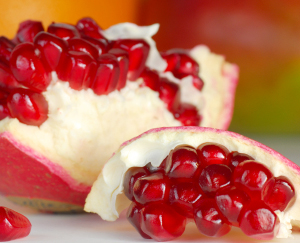Penn Herb Wellness Guide
Give Old Favorites a New Twist with Pomegranate

Dress up any dish
Each pomegranate contains hundreds of tiny seeds encased in juice-rich ruby pulp. Devin Alexander, a chef and author of The Most Decadent Diet Ever (Broadway Books, 2008), suggests adding seeds to a salad and using the juice to make salad dressing. “The seeds are also great to add natural sweetness to black rice and whole grain pilaf dishes,” she notes.
The pomegranate’s sweettart taste, ruby color, and many little seeds can add flavor and crunch to a wide variety of dishes. Sprinkle seeds into soup or add to baked goods. For a fresh twist to an old standby, add a tablespoon of the juice and three tablespoons of seeds to guacamole. Or try Alexander’s favorite use of the fruit, a variation on the traditional Purple Cow ice cream soda. “I love making Pomegranate Cows. I use pomegranate juice and vanilla frozen yogurt instead of grape juice and ice cream for a much healthier treat.”
Why pick pomegranate?
You’d be hard pressed to find a healthier treat than the pomegranate. It’s filled with nutrients and loaded with antioxidants. Research indicates that it can help lower blood pressure, reduce LDL (bad) cholesterol, prevent the cartilage damage that leads to osteoarthritis, slow progression of prostate cancer, and protect the arteries from plaque buildup. So isn’t it time to try this superfood?
Picking and prepping
Look for fruit that is heavy for its size (and therefore juice-filled) and has bright, unblemished skin. When refrigerated in a plastic bag, pomegranates will keep for up to two months. Loose seeds can be refrigerated for up to three days, or frozen in single layers on trays and in airtight containers for up to six months. Juice can be refrigerated for up to three days, orfrozen forup to six months.To prepare the fruit fresh:
- Cut the crown end off the pomegranate, and then lightly score the skin from top to bottom in quarters.
- Immerse the fruit in a bowl of cool water and soak for a minute or two. Then break sections apart.
- Seeds will sink to the bottom of the bowl; rind and membrane will float. Skim off and discard the rind and membrane. Scoop up and drain seeds, and then pat dry.
And if that’s too much trouble, let someone else do the work: shop for 100% pomegranate juice.
Copyright 2026 TraceGains, Inc. All rights reserved.


